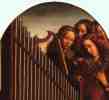![]()
 Adoration of the Lamb
Adoration of the Lamb
detail: top half of panel depicting angelic musicians,
1432 (50 Kb); Cathedral of St. Bavo, Ghent
 Adoration of the Lamb
Adoration of the Lamb
detail: bottom half of panel depicting angelic musicians,
1432 (30 Kb); Cathedral of St. Bavo, Ghent
Jan van Eyck (1385-1441) was a contemporary of Campin and one of the enduring influences on his century. He had an eye almost miraculously responsive to every detail or his world, not just in that he saw it, but that he understood its value. Van Eyck's natural habitat was one of luminous clarity; he saw the most ordinary things with a wonderful sharpness and a great sense of their awesome beauty. We know little about him personally, but he is the most overwhelming of painters in the convictions he enables us to share.
Like the 17th-century Dutch painter Vermeer, van Eyck takes us into the light, and makes us feel that we, too, belong there. Van Eyck's meticulously detailed Adoration of the Lamb is part of a huge altarpiece; painted on both sites, it is the largest and most complex altarpiece produced in the Netherlands in the 15th century. This monumental work still hangs in its original setting, the Cathedral of St Bavo in Ghent, drawing the worshipper deeper and deeper into the sacred world it makes visible. There has been much debate over the parts the two van Eyck brothers, Jan and Hubert, played in the creation of the Ghent Altarpiece: whether Jan, about whom we have the most information, was mostly responsible, or whether it was Hubert, about whom we know almost nothing. For what it is worth, Hubert is given precedence in the inscription. It reads: ``The painter Hubrecht Eyck, than whom none was greater, began this work, which his brother Jan, who was second to him in art, completed at the behest of Jodoc Vijdt...''
A panel shows the sacrificial Lamb on the high altar, its sacred blood pouring into a chalice. Angels surround the altar, carrying reminders of the Crucifixion and in the foreground gushes the Fountain of Life. Coming from the four corners of the earth are the worshippers, a diverse collection that includes prophets, martyrs, popes, virgins, pilgrims, knights, and hermits. It is likely, as with many great religious works of the time, that van Eyck would have been advised by a theologian, and these figures seem to represent the hierarchy of the Church. Set in a beautiful, lush landscape, the holy city gleams on the horizon, its outline very much that of a Dutch city; the church on the right is probably Utrecht Cathedral. The very perfection and accuracy, the convincingness of the vast altarpiece explain why this mystic vision has laid such a hold on the affections of those who see it. The Ghent Altarpiece envelops the viewer in a mood of contemplation, but any more rigorous analysis becomes a massive intellectual effort. We can move more easily into a smaller painting, such as his long, slender Annunciation.